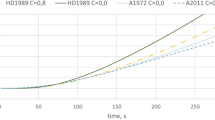Abstract
A series of National Fire Protection Association full-scale tests involving sprinkler installations was conducted in a two-story residence in Los Angeles, CA, and in a mobile home in Charlotte, NC. Previous laboratory tests, including full-scale room fire tests, had indicated that a prototype “quick-response” sprinkler was effective in controlling residential home fires. More full-scale fire tests under less controlled and more operational conditions were considered necessary to confirm or deny this conclusion. Part I of this three-part series (November 1983) explained the objectives of the tests and the test procedures that were to be followed. This second part describes the criteria used to evaluate the effectiveness of sprinkler systems using the “quick response” sprinkler in the series of seventy-six tests and the results of those tests. Part III will cover that phase of the test program that focused on a comparison of sprinkler and smoke detector activation times in the mobile home test structure.
Similar content being viewed by others
References
Kung, Hsiang-Cheng, Spaulding, Robert D., Hill, Edward E. Jr., and Symonds, Alan P., “Field Evaluation of Residential Prototype Sprinkler,” Los Angeles Fire Test Program, Factory Mutual Research Corp. Norwood, Mass., FMRC J.I. OEOR3. RA(1) (February 1982).
National Fire Protection Association, “Operation School Burning,” Official Report conducted by the Los Angeles Fire Department, April 16, 1959 to June 30, 1959.
Kimmerle, G., “Aspects and Methodology for the Evaluation of Toxicological Parameters during Fire Exposure,”Journal of Fire and Flammability/Combustion Toxicology, Vol. 1 (February 1974), pp. 4–41.
Pryor, A.J. and Yuill, C.H., “Mass Fire Life Hazard,” prepared for the Office of Civil Defense under Contract N228 (62479) 68665, Southwest Research Institute, San Antonio, TX (1966).
O'Neil, John G. and Hayes, Warren D. Jr., “Full-Scale Fire Tests with Automatic Sprinklers in a Patient Room,” NBSIR 79-1749, Center for Fire Research, Washington, DC (June 1979).
Stewart, R.D., et al., “Experimental Human Exposure to High Concentrations of Carbon Monoxide,”Architectural Environmental Health, Vol. 26 (January 1973), pp. 1–7.
Halpin, B.M. and Berl, W.G., “Human Fatalities from Unwanted Fires” Report NBS-GCR-29-168, National Bureau of Standards, Washington, DC, (1978).
Claudy, W.D., “Respiratory Hazards of the Fire Service,” National Fire Protection Association, Boston, MA (1957).
Rabash, D.J., “Sensitivity Criterion for Detectors Used to Protect Life” paper presented at the International Seminar on Automatic Fire Protection, Aachen, West Germany (March 1975).
Harland, W.A. and Wooley, W.D., “Fire Fatality Study,” Information paper IP 18/79, University of Glasgow, Glasgow, Scotland, Building Research Establishment (1979).
Roden, Martin S. and Graham, Thomas M., “The California Fire Chiefs Association Residential Fire Detector Test Program,” California State University, Los Angeles (September 1979).
Kung, H., Spaulding, R., and Hill, E. Jr., “Sprinkler Performance in Residential Fire Tests,” Factory Mutual Research Corporation, Norwood, MA (July 1980).
Additional information
National Fire Protection Association
Mr. Cote is Assistant Vice President (Engineering & Technical Services) for the NFPA. He served as project manager for the test series insofar as the NFPA had overall management responsibilities for the program.
Reference: Cote Arthur E., “Field Test and Evaluation of Residential Sprinkler Systems: Part II” Fire Technology, Vol. 20, No. 1, February 1984, p. 48.
Rights and permissions
About this article
Cite this article
Arthur, E., Cote, P.E. Field test and evaluation of residential sprinkler systems: Part II. Fire Technol 20, 48–58 (1984). https://doi.org/10.1007/BF02390047
Issue Date:
DOI: https://doi.org/10.1007/BF02390047




